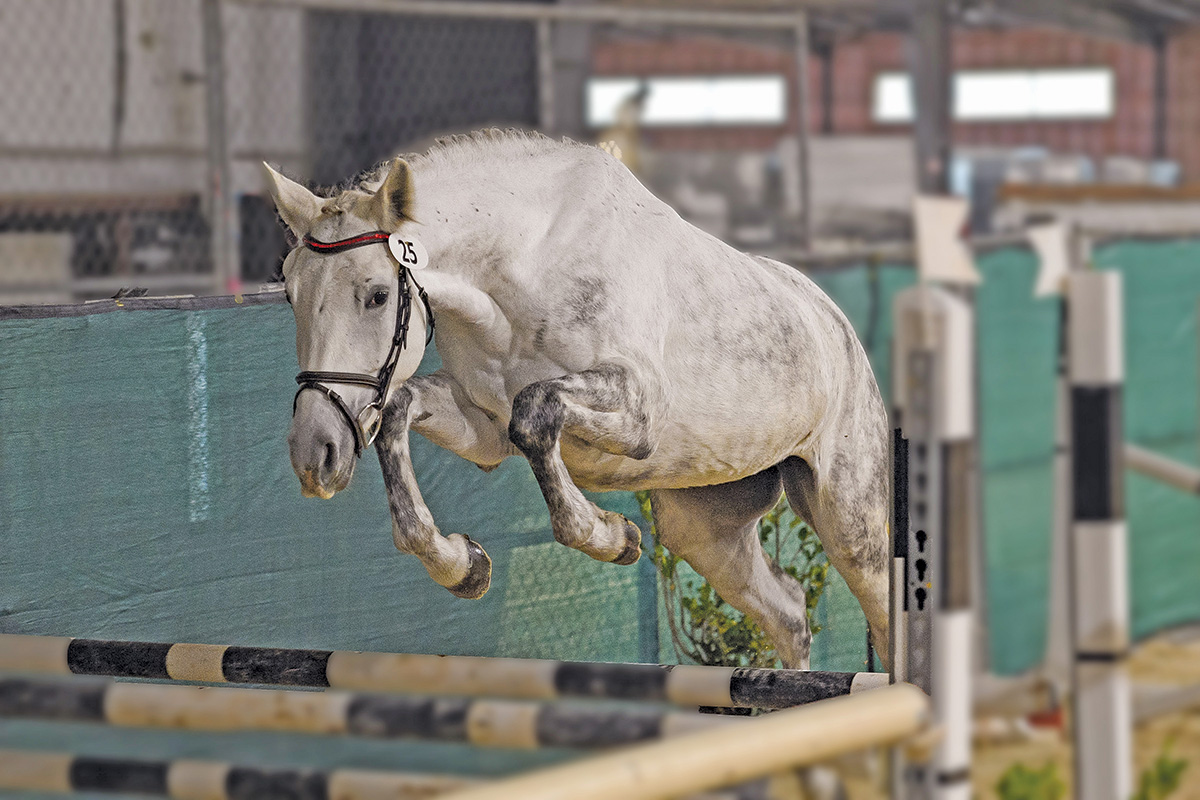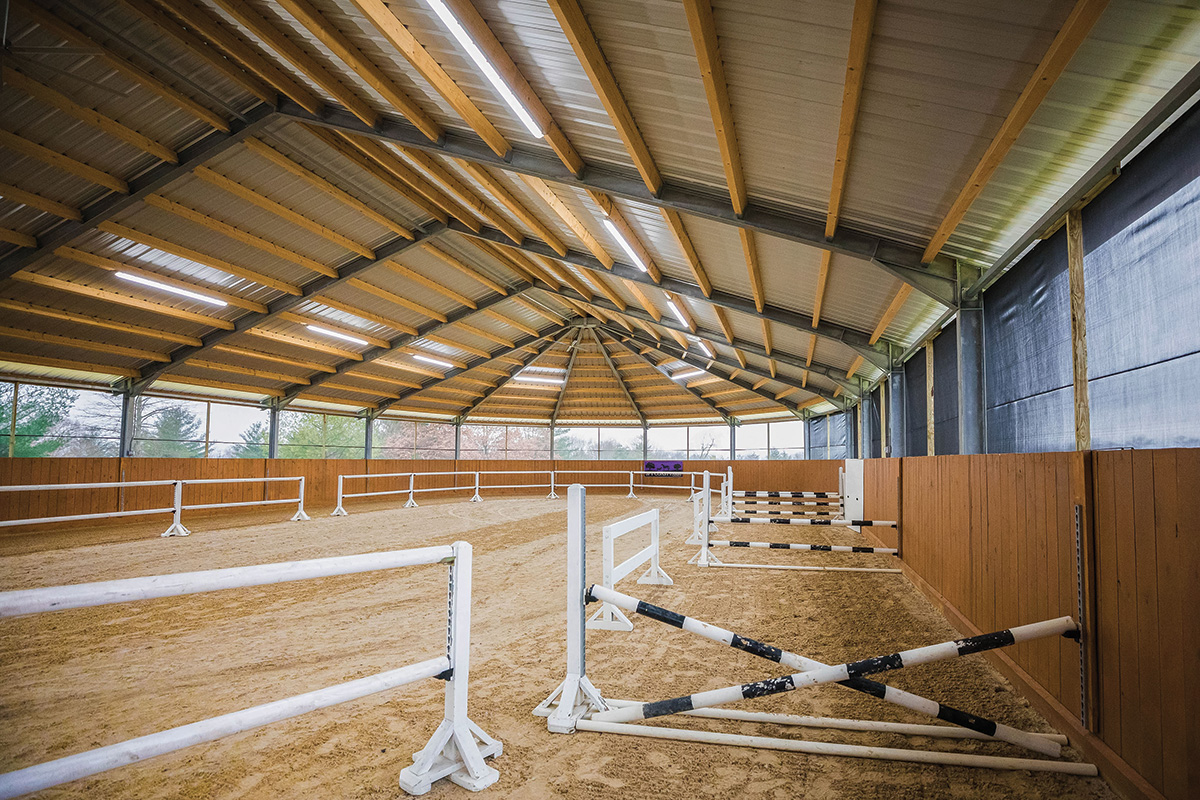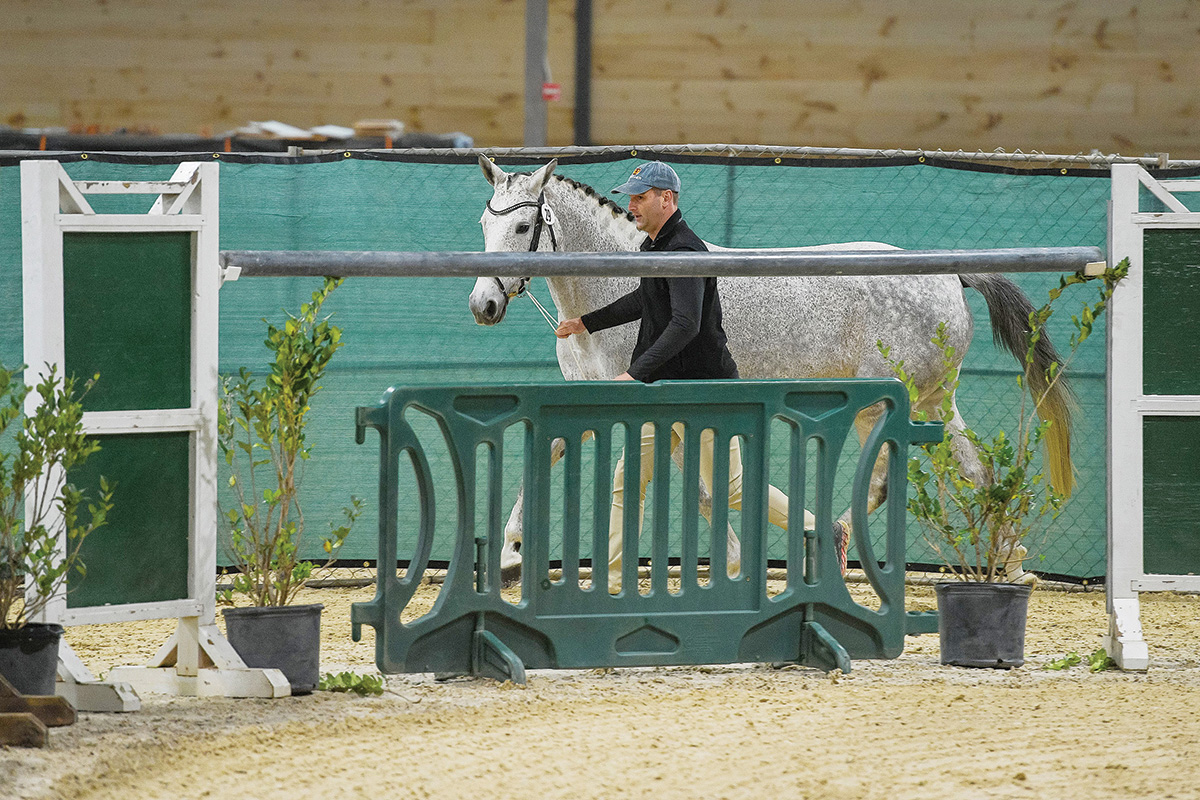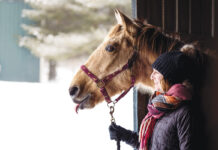
A riderless sport horse negotiates a series of ground poles and small jumps, finding his wings along the way. This is free jumping, where the obstacles are aligned in a row down a chute positioned on the long side of an arena. It’s fun to watch, yet a bit mystifying too. How does one teach a horse to free jump?
Why Free Jumping?
Thompson lists a number of reasons to free jump horses. These include assessing jumping talent, showing a client how their horse is progressing, as a marketing tool for selling young jumpers, building confidence in an older show horse, or helping a horse through fear of certain types of fences.
“It’s a great way to give a horse time to figure out jumping fences by himself so he gains confidence,” explains Thompson. “Then when it comes to doing it under saddle, he already has a greater understanding. He’s used to it without the influence of a rider, so it’s not sensory overload. It gives him the best chance possible of becoming a confident and capable jumper down the line.”
In the spring of their 2-year-old year, Spy Coast free jumps the colts they are considering as stallion prospects to sort out which will be gelded. This allows them not only to observe the individual colt’s jumping talent, but also assists in evaluating each colt’s temperament and trainability.
“With stallions, you want to be looking to pass on all the best traits that you possibly can,” says Thompson.
In addition to all of these reasons, free jumping can be a fun way to bond with your horse, as long as you prepare properly. Thompson offers the following step-by-step advice.
Study the Process
To observe the process, you can go to breed inspections, young horse shows, and/or clinics on free jumping. Take notes and ask questions. Volunteer where needed and learn by doing.
Pay attention to how horses going through the chute react to different jumps, handlers, the longe whip, and other cues. Observe where their eyes and ears are focusing. Learn to read their body language to predict whether the horse will go through the chute willingly or if he is thinking about stopping before a jump. See if you can tell if the horse feels relaxed and confident or rushed, confused or panicked.
Facilities & Equipment
A smaller arena is better for free jumping so the horse doesn’t wear himself out in between jumping passes. It also makes the horse easier to catch. Thompson says something on the order of a standard dressage ring dimensions (20 meters by 60 meters) would work well. A larger arena can be subdivided for free jumping, and an indoor arena is generally better than an outdoor for this purpose.

◆ You’ll need enough poles, jump standards and jump cups to build the jump chute, with extras built into the count.
◆ For the sides of the chute, additional jump standards can be turned sideways and used with extra rails, or stand-alone fence panels may be used. The materials should be safe if the horse runs through them. Things such as yellow plastic caution tape, carpenter’s saw horses, tall potted plants, traffic cones, or stacked straw or shavings bales may all be useful chute barriers.
◆ Thompson says they use three handlers when free-jumping at Spy Coast: one to lead the horse into the chute, one along the middle of the chute to keep the horse on track and moving through, and one to catch the horse on the far end.
◆ Enough lead ropes and longe whips so that each handler has both.
◆ Cord or leather lace (about 36 inches in length) to loop through the near bit ring to lead the horse up to chute that easily slides away for quick release.
◆ Bucket filled with feed or treats to entice the horse to stop and be easily caught after each jumping pass.
◆ Quick release snaps on rein ends to easily detach/attach them to bit rings. These are great for inspections or any time you are free jumping the horse in a bridle.
◆ Camera or video camera to record the session.

Jump Chute Construction
There are a number of variations on the theme for free jump chute building, but they all use similar distances between poles and jumps:
◆ 9 feet between the placing pole on the ground (which encourages the horse to trot into the chute and sets him up for takeoff) and the first cross-rail fence.
◆ 21 feet from the cross-rail to the first vertical
◆ 22-24 feet to the final fence, which eventually becomes an oxer.
The distance between fences may need to be adjusted for horses with different stride lengths. Watch to see if the horse struggles to make a too-long distance or has hard time fitting into a too-short distance as he travels through the chute.
There also need to be points along the inner jump chute wall that can be quickly opened (to at least 4 feet wide) on the takeoff side of each jump in case a horse gets flustered and stops in the middle of the chute. This allows a handler to enter the chute, calmly catch the horse, then lead him safely out the side. The horse can then be prepared to re-enter for another try.
Introducing Free Jumping to the Horse
Thompson stresses that the horse should lead well, respect your space, and know how to longe and/or free longe before teaching him to free jump. He should know voice commands and consistently follow body language and whip cues.
At Spy Coast, they first lead the horse calmly through the chute (with no jumps up) and reward him with food from a bucket placed at the far end, well after he’s left the chute. He cautions that they don’t want the horse to get used to stopping for a reward immediately after the final jump, but rather the horse should get used to landing and traveling away from the jump before getting his treat.
At the same time, they tell the horse “whoa” so that he can equate the word with stopping at that spot and the reward. They do this with the horse a few times, then trot him in-hand through the chute with a reward again.
Thompson explains how they progress slowly from going through the empty chute at liberty and then introducing ground poles and later jumps in the chute. They start off with just a single pole at the end.
“From there, we build it up to where we have three poles down and maybe the placing pole at the beginning,” he says. “Then we lead the horse over the poles until he is comfortable with that. Then we add a small cross-rail at the end so he moves down through the poles and pops over the cross-rail. When the horse is confident with that, then we make a second cross-rail, then a third. Usually they get the whole idea and seem to say, ‘Oh, I’m popping around and going to the food.’”
Over time and several sessions, they build up to verticals and oxers, and perhaps later the jumps become higher and wider, depending on the experience and age of the horse at the time. The handlers should also be well-versed in helping the horse safely progress beyond poles and cross-rails.
Thompson emphasizes that throughout the process, the horse needs to remain quiet. Don’t rush him through the chute by pushing too hard with voice, body language or whip. If the horse makes a mistake, then go back down a level and start again until he is confident.
He advises keeping the jumping sessions short, no longer than 15 to 20 minutes.
Safety Tips
Thompson says that communication between the humans in the ring as a horse is free jumping is key for safety. If possible, he would like to have the horse track be separated from the middle of the ring all the way around, not just in the jump chute, so that there is a safe place for people to be.
He advises that one person keeps an eye on the horse at all times while others are resetting the jumps to avoid a horse running in before the chute is ready and potentially running over a person or hurting themselves.
Handlers should all have longe whips—not only to direct the horse through the chute, but also to push him away from the handler and other people in the ring. Caution should be taken when catching a horse, since they can sometimes spin and kick out at the last moment.
Thompson uses protective legwear (tendon and bell boots) on horses with shoes, but doesn’t usually use them on younger barefoot horses, since he wants to be able to evaluate their jumping without any effect on style that the boots might cause.
Reading the Horse
Over time, you’ll be able to see when your horse understands what is being asked. At this point, you’ll know you can safely progress.
Some horses need to have the jumps changed more often to keep them thinking about the task and not rushing through the chute. Others need more time to figure things out at a lower level. Some will need adjustment in distances between jumps or extra ground poles placed to assist them in jumping better.
Thompson points out that as a young horse develops, his jumping style may change a bit. He also shares that there are horses that, no matter how carefully you prepare, consistently want to speed through the chute. Those horses may learn more by jumping under saddle.
Find full instructions on setting jump chutes, including diagrams, here.
About the Expert Ciaran Thompson is the head trainer at Spy Coast Farm in Lexington, Ky., in their Young Horse Development Center. Growing up, he was an active member of Pony Club in Ireland, where he received his A rating. He has been at Spy Coast Farm since 2017, starting as Young Horse Trainer, developing 2- and 3-year-old horses, and has been Head Trainer since 2022, overseeing the production of horses from their first rides under saddle to competing at FEI events in both show jumping and eventing. |





